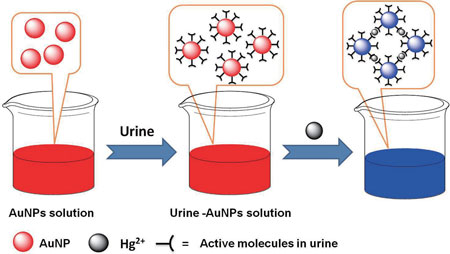| Posted: Jul 12, 2013 | |
Bioinspired nanotechnology colorimetric assays - turning trash into treasure |
|
| (Nanowerk Spotlight) Colorimetric sensing techniques require only the naked eye or ordinary visible color photography and are attractive because of their low cost, use of inexpensive equipment, and above all, their simple-to-understand results. Colorimetric sensor can be used for both qualitative analytic identification as well as quantitative analysis and find a wide range of applications in chemical and biomolecular analysis (see for instance: "The world's most sensitive plasmon resonance sensor inspired by ancient Roman cup") as well as integration into portable microfluidics lab-on-chip devices (see: "DNAzymes and gold nanoparticles: A colorimetric assay for diagnostics in the field"). | |
| "Generally, a colorimetric probe consist of a recognition moiety and a signal moiety," Xiaodong Chen, an assistant professor in the School of Materials Science & Engineering at Nanyang Technological University, explains to Nanowerk. "The sensing strategy is that the recognition moieties exhibit selective response to targets depending on either coordination or chemical reactions between targets and ligands. The signal moiety – usually an organic chromophoric probe – then translates those detecting behaviors into color changes discernible by the eye. Both the components are indispensable and can affect colorimetric performance in terms of selectivity, sensitivity, response time, and so on." | |
| Chen points out that for signal moieties, plasmonic nanoparticles, especially gold or silver, are preferable to organic chromophores due to their superior properties and that plasmonic nanoparticle-based colorimetric detection has drawn increasing attention due to the unique optical properties provided by surface plasmon resonance. | |
| "For the recognition moiety, most probes are usually prepared by functionalizing chemically synthesized ligands on various chromophores or nanostructures for their special coordination chemistry with targets," says Chen. "For instance, thymine in DNA strands can be use for mercury ion (Hg2+) detection through a T-Hg2+-T complex, where Hg2+ selectively bridges two thymine molecules in a stable manner. However, in order to avoid this complicated synthesis and develop environment-friendly green methods, we think utilizing natural products is one of the most straightforward, simple, and preferred strategies, which is also consistent with the idea of green health and practical economy." | |
| In new work, reported in the June 28, 2013 online edition of Small ("Urine for Plasmonic Nanoparticle-Based Colorimetric Detection of Mercury Ion"), Chen and his team developed a plasmonic colorimetric assay to detect mercuric ion based on urine. Compared to other gold-nanoparticle-based colorimetric systems, it showed excellent selectivity to Hg2+, especially without the interference from the Pb2+, and good sensitivity as high as can be used for Hg2+ detection in industrial wastewater. | |
 |
|
| Schematic of the colorimetric detection of Hg2+ based on simply mixing urine and gold nanoparticles (AuNPs). The active components (uric acid and creatinine) in urine decorated on AuNPs are the reason for selectively binding Hg2+, leading to the aggregation of gold nanoparticles and thereby causing a visual color change. (Reprinted with permission from Wiley-VCH Verlag) | |
| Specifically, the scientists carried out the strategy of loading ?green? candidates on plasmonic nanoparticles for colorimetric assays, which is based on the synergistic effect of small molecules on the particle surface for target recognition. As a proof-of-concept, they realized their idea by fabricating a urine-nanoparticle system by just mixing urine and gold nanoparticles together directly with the proper ratio for colorimetric determination of Hg2+. | |
| The assay hinges on the stark red-to-blue color change of the gold nanoparticle solution upon contact with Hg2+ and its good sensitivity, owing to the large surface-to-volume ratio and much higher absorption extinction coefficient as against traditional organic chromophoric probes. | |
| "The synergetic effect of uric acid and creatinine, existing in urine and decorated on gold nanoparticles, is the reason for selectively binding Hg2+, leading to the aggregation of gold nanoparticles and thereby causing a visual color change," explains Chen. | |
| In addition, he notes, the novelty of such an assay lies in its simplicity, inexpensiveness, and portability – without ligand synthesis, just using urine directly – which is very useful in remote and less industrialized areas. Finally, this assay development may show as a good example to exploit natural products in exploring nanotechnology. | |
| "In my view, bio-inspired applications are some of the most possible and practical directions for plasmonic nanoparticle-based assays and are a kind of green chemistry that is very considerate of health, environmental, and sustainability issues," says Chen. "Learning from nature never ends and is so intriguing because it offers many possible solutions to our everyday problems, for instance: 1) bio-inspired mechanisms, such as hydrogenase for hydrogen; 2) bio-interface-inspired multifunctional structures designed and fabricated for different applications inspired by lotus leaves, butterfly wings, water strider legs and so on; 3) using the active constituent in natural products directly, such as functionalizing enzymes on nanomaterials for catalyzing/sensing as well as synthesizing gold nanoparticles depending on polyphenols inside tea leaves." | |
 By
Michael
Berger
– Michael is author of three books by the Royal Society of Chemistry:
Nano-Society: Pushing the Boundaries of Technology,
Nanotechnology: The Future is Tiny, and
Nanoengineering: The Skills and Tools Making Technology Invisible
Copyright ©
Nanowerk LLC
By
Michael
Berger
– Michael is author of three books by the Royal Society of Chemistry:
Nano-Society: Pushing the Boundaries of Technology,
Nanotechnology: The Future is Tiny, and
Nanoengineering: The Skills and Tools Making Technology Invisible
Copyright ©
Nanowerk LLC
|
|
|
Become a Spotlight guest author! Join our large and growing group of guest contributors. Have you just published a scientific paper or have other exciting developments to share with the nanotechnology community? Here is how to publish on nanowerk.com. |
|
